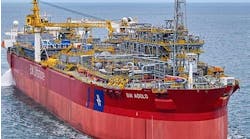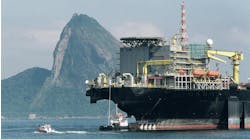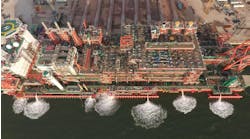SUBSEA PRODUCTION Shell hurdles high pressures and temperatures for North Sea tiebacks
Special handling innovations developed for HTHP production
Jeremy Beckman
Editor, Europe
- Mallard-Kittiwake area development plan.
- Location of Shell's new Kingfisher development.
- The Kingfisher Field is conveniently located for a third-party tieback to the Brae complex.
Even a year ago in the North Sea, the chances of producing high pressure/temperature hydrocarbons subsea seemed remoter than finding life on Mars. Now, Shell UK Expro has shaken typical engineering think by unveiling two such developments - Mallard and Kingfisher.
With Erskine, the first North Sea HT/HP field, not due onstream until next year, Shell had no experience to fall back on for these two projects. Key equipment items demanded novel solutions, which Shell paid the contractors to devise and competitively tender.
Some of the ideas that were turned down could still be resurrected for future HT/HP projects. Shell is already looking ahead by sponsoring work on a subsea tree rated for 15,000psi, 200 degree C duty.
Mallard heat loss
Strictly speaking, the difficulties with the two current developments relate either to the wellstream temperature or the wellhead pressure, but not both concurrently. On Mallard, the challenge was 150 degree C wellhead fluids.
Mallard lies in Central North Seablock 21/19 in 90 meters of water. The reservoir, discovered in 1990, is 4,000 meters below the seabed. Shell/Expro's Kittiwake production platform 15 km away was the obvious host for the subsea tieback, but the dilemma for Shell was whether to design the pipeline for 150 degree C conveyance, or somehow to cool the fluids prior to entering the line.
Cooling won. Pipelay contractor Allseas suggested a coil housed in a cage between the wellhead and the pipeline. As the wellstream fluids enter the coil, they would be cooled by surrounding seawater to 100 degree C before passing onwards into the pipeline. At this temperature, reinforced wall thickness would not be necessary for the pipeline.
Allseas also designed a pipe-in-pipe solution deploying strain-based analysis to determine safe operating limits. Mechanical properties of the chosen material at high temperatures were full-scale tested in Rotterdam earlier in the year. Finite element analysis was also performed on the connectors between the inner and outer pipes to investigate upheaval buckling potential of the pipe-in-pipe system in severe operating conditions.
Among the other measures to mitigate the effect of Mallard's heat, the project team has been looking at linepipe materials, following on from tests performed by Shell UK Expro for the multi-field ETAP project at temperatures ranging from 110-160 degree C. Mannesmann in Germany and a Mexican manufacturer were involved in that program. Currently, pipes from other mills are being evaluated for Mallard, according to project manager Luuk Wellens.
Shell group has backed research and development for some time into pipeline coatings that could withstand temperatures up to 160 degree C. Tests have been performed on a modified elastomer, and sprayed-on aluminium coating has also been investigated. There have been failures, but a technique that proves durable could be applied on Mallard.
Out on location currently, Sedco Forex is drilling two wells, a producer and a water injector which will be managed through 8-in. flowlines. Shell aims to have Mallard onstream in October 1997 at a cost of UKP 100 million. Some of this will go on a new module built by SLP for the host platform to process Mallard's oil and associated gas at 16,000 b/d and 11 MMcf/d, respectively. The processed crude will be offloaded to a tanker, with the gas piped to St Fergus. Shell puts the total recoverable at 25 million bbl and 17 bcf.
Kingfisher strains
High pressure and sour fluids have held back development of the Kingfisher oil, gas and condensate field since its discovery in 1972 in UK Block 16/7a in 110 meters of water. The processing problems will be handled by Marathon and partners on the Brae B platform, 9 km to the west, following installation of a new three-phase production separator, metering equipment and added chemical injection. Kingfisher will thereby become the second third party field to be processed on Brae platforms, as well as the twelfth to be tied back to Brae Area infrastructure.
Kingfisher actually comprises three separate reservoirs. Of these, the Heather reservoir presents the presssure challenge, at least for the first two years of production, after which depletion should normalize flow rates. Wellstream temperature is also above the North Sea norm, without being excessive.
Currently six wells are being drilled on the field by the rig John Shaw (including multi-laterals) under a program due to last into 1999. However, first oil is due out late next year. Water injection may be added at a later date.
The wellheads will be grouped around and tied back to a subsea production manifold. There the well fluids will be commingled before heading out to Brae B via two 10-in. nominal bore super duplex pipelines operating in a multiphase regime. Prior to commingling, however, Heather's wells, with their initial closed-in tubing pressure of 9,000 psi, will be fed through a subsea high integrity pressure system (HIPPS).
According to a Kingfisher project manager, this concept has been applied before on the North Sea on topsides where there is a need to keep a separator rated at the same pressure as the flowline connected to it. It was initially considered by Shell for ETAP, but Kingfisher will be the first application subsea.
Basically, the system will comprise additional subsea isolation valves and emergency shutdown (ESD) valves housed within the manifold, but totally independent of the main subsea control system. Kvaerner FSSL is working on the HIPPS, employing GTI ESD valve equipment. Onshore trials will be performed prior to installation.
Once pressure has been lowered, the Heather fluids will then be commingled with the rest of the wellstream. After two years in service, with pressure naturally reduced, the equipment will likely be removed.
Using HIPPS will reduce capital expenditure on the project, according to the spokesman, partly because it allows wall thickness of the pipelines to be safely reduced. ABB Vetco Gray is supplying subsea trees rated at higher than normal North Sea pressures, but other pressure-related modifications are not significant.
Next summer, McDermott Subsea Constructors vessels Norlift and Northern Explorer will install the manifold, built by Consafe, as well as the pipelines, risers, control and injection umbilical and other equipment. AMEC Process and Energy will manage the Brae B topsides installation concurrently during a pre-planned shutdown. Flowline risers and umbilicals from Kingfisher will be connected to the topsides via a new caisson in a spare conductor slot and a spare, pre-fitted J-tube.
Fluids emerging from the separator will be individually metered (the platform also handles output from the Beinn Field). Brae B is where Marathon pioneered use of the gas cycling production technique offshore to maximizes liquids recovery from gas condensate fields.
Kingfisher's statistics are 56 million bbl of oil/condensate and 368 bcf of gas recoverable. From Brae B, the processed liquids will funnel through the Brae-Forties pipeline system to Cruden Bay, with the gas being piped to St Fergus. Peak production is estimated at 37,000 b/d of condensate and 160 MMcf/d of wet gas, over a field life of around nine years.
Breakthrough for trees
The heat and pressure will really be on if Shell decides to go subsea on Shearwater. At 1.0-1.5 tcf of gas and 100-150 million bbl of liquids, this is the largest of the UK Central North Sea HT/HP reservoirs (it caused a blow-out when discovered by the semi Ocean Odyssey in 1988).
Shell has begun issuing contracts for the topsides hardware, but Shearwater is also thought to be a candidate for a new range of subsea trees under development by ABB Vetco Gray which is part funded by Shell. The aim is to withstand wellhead pressures of 15,000 psi and associated temperatures of 150 degree C.
Steve Fenton, the responsible product technical manager at ABB Vetco Gray, outlined the status of the project at the recent IOCE subsea conference in Aberdeen. He said that tree vendors have lacked the commercial stimulus to attain these levels, with most operating applications still confined to 5,000-10,000 psi and well below 120 degree C. Also, an upgrade to higher levels, taking into account verification tests and analysis, looked formidably pricey to manufacturers - until now.
ABB Vetco Gray is reaching toward the new targets through a three-phase development program. The first phase, covering preliminary design confirmation, has just been completed. Among the findings Fenton listed were:
- A 5-1/8in. by 2-1/16-in. tree system, rated at 15,000 psi, is practical, subject to further work on interfaces with tubing plug vendors.
- Some performance verification testing is needed to establish capability as regards tree to tubing hanger metal stab seals and SSSV couplers.
- Further tests are necessary on other elements of the system to validate structural load capacity, or to further verify viability for 150 degree C operations. These include the tubing hanger annulus metal seal, casing hanger annulus metal seal, valve bore metal sealing mechanisms, wellhead, flowline and re-entry connectors, and riser stab seals.
- Finally, more detailed heat transfer analysis is needed to simulate behavior of the system and to understand sensitivity to heat inputs and associated boundary layer effects.
Fendon said there were other factors impacting development of upper range hardware, such as the limited availability of large bore HTHP SSSVs. But ABB Vetco Gray had taken this into account by working towards a standardized system capable of maximizing production throughput. The program is catering for incremental developments in downhole technology as well as the radical changes which might occur through proliferation of multilaterals.
According to Fenton, Shell's funding has been directed at investigating the readiness of such a system for several applications just around the corner: work has focused on parallel well configurations. Phase 2, covering detailed engineering of the system, should be finished this month, with the final performance verification testing phase due to be completed by mid-1997.
The aim is to demonstrate the competability of the new system with current 10,000 psi systems.
Aside from extending operating limits, the system is being designed to allow installation by the same jack-up drilling the wells, but with the flexibility to use a semi later on for workovers. One problem, said Fenton, is the high pressure riser for the completion riser system, because currently there are no 18-3/4-in. drilling riser systems available.
Once these little details are sorted out, Fenton anticipated typically 90 days for drilling an HT/HP well, plus 25 days for the completion. If a quality riser were chosen, he added, UKP 3.5 million/per well could be saved. However, an HIPPS would also probably be needed.
Copyright 1996 Offshore. All Rights Reserved.


